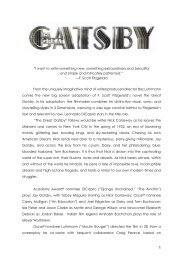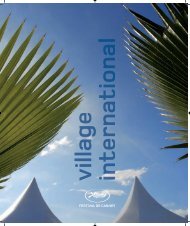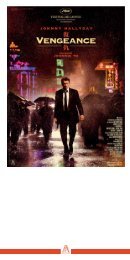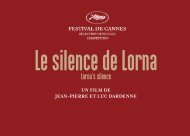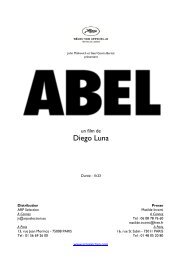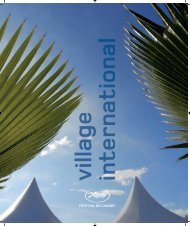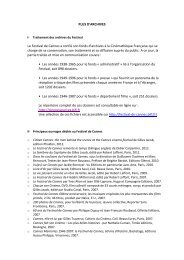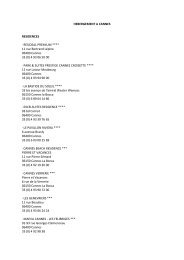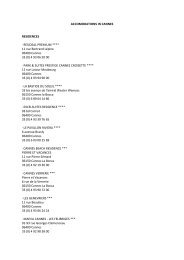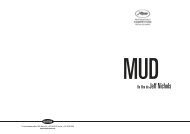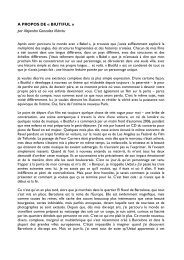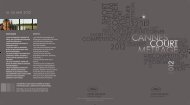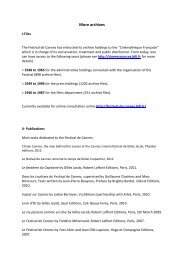SynopSiS - Cannes International Film Festival
SynopSiS - Cannes International Film Festival
SynopSiS - Cannes International Film Festival
Create successful ePaper yourself
Turn your PDF publications into a flip-book with our unique Google optimized e-Paper software.
INTERNATIONAL SALES<br />
MK2<br />
55 rue Traversière - 75012 Paris France<br />
intlsales@mk2.com<br />
Ph: +33 (0)1 44 67 30 30<br />
www.mk2pro.com<br />
Juliette SCHRAMECK Head of <strong>International</strong> Sales & Acquisitions<br />
juliette.schrameck@mk2.com • +33 (0)6 86 43 07 52<br />
Dorothée PFISTNER Senior Sales & Acquisitions Executive<br />
dorothee.pfistner@mk2.com • +33 (0)7 60 83 98 65<br />
Victoire THEVENIN <strong>International</strong> Sales Executive<br />
victoire.thevenin@mk2.com • +33 (0)6 69 55 57 05<br />
Clémence PERRIER-LATOUR Marketing & <strong>Festival</strong> Manager<br />
clemence.perrier-latour@mk2.com • +33 (0)1 44 67 30 11<br />
PRESS<br />
Charles MCDONALD<br />
Email: charles@charlesmcdonald.co.uk<br />
Cell: + 33 (0)7 86 72 44 87<br />
Matthew SANDERS<br />
Email: matthew@magiclanternart.org.uk<br />
Cell: +44 7815 130 390<br />
NathaNaël Karmitz Charles Gillibert aNd ameriCaN zoetrope preseNt<br />
A FILM DIRECTED BY WALTER SALLES<br />
BASED ON JACK KEROUAC’S NOVEL<br />
WITH<br />
GARRETT HEDLUND SAM RILEY KRISTEN STEWART<br />
AMY ADAMS TOM STURRIDGE DANNY MORGAN ALICE BRAGA<br />
ELISABETH MOSS KIRSTEN DUNST VIGGO MORTENSEN<br />
DCP and 35 mm - image 2.35 - sound : 5.1 / Dolby SRD / SR / DTS - color - France, Brazil - 137 min.<br />
Pictures and press kit downloadable on www.mk2pro.com
<strong>SynopSiS</strong><br />
Just after his father’s death, Sal Paradise, an aspiring New York writer, meets<br />
Dean Moriarty, a devastatingly charming ex-con, married to the very liberated and<br />
seductive Marylou.<br />
Sal and Dean bond instantly. Determined not to get locked in to a constricted<br />
life, the two friends cut their ties and take to the road with Marylou. Thirsting for<br />
freedom, the three young people head off in search of the world, of other encounters,<br />
and of themselves.<br />
The only people for me are the<br />
mad ones, the ones mad to live,<br />
mad to talk, mad to be saved,<br />
desirous of everything at the<br />
same time, the ones who never<br />
yawn or say a commonplace<br />
thing but burn, burn, burn<br />
like fabulous roman candles<br />
exploding like spiders across<br />
the stars... - Jack Kerouac -<br />
SYNOPSIS<br />
4 - 5
A TRAVELER’S GUiDE<br />
The protagonists of the Beat Generation each had their alter egos in Kerouac’s book<br />
On the Road. These characters are not portrayed by actors in the adaptation of the<br />
book for the big screen. A look at the impressive cast.<br />
The whole text can be found in Trois Couleurs Special Issue #8<br />
© Carolyn Cassady<br />
© Hal Hinkle<br />
nEAL CASSADy<br />
JACk kERoUAC<br />
REALiTy / book / moViE<br />
DEAn moRiARTy GARRETT HEDLUnD<br />
REALiTy book moViE<br />
Iconic Beat poet, Neal Cassady was charming but<br />
burned out, avidly chasing after freedom, road miles<br />
and women. Kerouac travelled with him to some very<br />
out-of-the-way spots in the United States; these wild<br />
adventures are narrated in On the Road, where Neal<br />
becomes Dean Moriarty, the charismatic adventurer<br />
who intimidates Sal Paradise. The role could have<br />
been given to Marlon Brando or Brad Pitt, but<br />
is finally played by the cheeky Garrett Hedlund<br />
(TroY, TroN: LeGACY). Q. G.<br />
SAL pARADiSE SAm RiLEy<br />
REALiTy book moViE<br />
“King of the Beats”, Jack Kerouac was a vagabond<br />
angel whose spontaneous prose placed him among<br />
some of the most important literary giants of the<br />
20 th century. In his masterpiece work, On the Road,<br />
he puts himself into the character of Sal Paradise,<br />
a slightly withdrawn young man fascinated by Dean<br />
Moriarty, who took him under wing as they took off<br />
across country. Following his role as Ian Curtis in<br />
CoNTroL, Sam riley incarnates Paradise, another<br />
counterculture icon. Q. G.<br />
Dean<br />
is the perfect<br />
guy<br />
for the road<br />
A TRAVELER’S GUIDE<br />
6 - 7
© Carolyn Cassady Photo courtesy of Anne Marie Santos and Gerald Nicosia<br />
LUAnnE HEnDERSon REALiTy<br />
mARyLoU book kRiSTEn STEWART moViE<br />
CARoLyn CASSADy REALiTy<br />
LuAnne married Neal Cassady at the age of 15 and<br />
divorced him soon after but remained his mistress for<br />
many years. She was with Dean and Sal as they travelled<br />
across the USA, experimenting with drugs, alcohol and<br />
other antics, often crude in nature. LuAnne is Marylou<br />
in On the Road. “I don’t resemble her at all,” proclaimed<br />
the actress Kristen Stewart who, before TWILIGHT,<br />
lent her acting talents to the role of a pouting and<br />
sensual muse on the road and in the wild in INTo<br />
THe WILD by Sean Penn. J. R.<br />
CAmiLLE book<br />
Played by the evanescent Kirsten Dunst (THe<br />
VIrGIN SUICIDeS, MArIe ANToINeTTe,<br />
MeLANCHoLIA), Carolyn Cassady, Camille in On the<br />
Road, is today eighty-eight years old. She was a courageous<br />
mother who raised her children fathered by Neal Cassady,<br />
while he would often hit the road on escapades with other<br />
young women. J. R.<br />
kiRSTEn DUnST<br />
moViE<br />
© Loomis Dean / Time & Life Pictures<br />
© John Cohen / Hulton Archive<br />
WiLLiAm S. bURRoUGHS<br />
ALLEn GinSbERG<br />
REALiTy<br />
REALiTy<br />
oLD bULL LEE book ViGGo moRTEnSEn<br />
Junkie guru, Williams S. Burroughs was the oldest and<br />
gloomiest of the original Beat clan. Considered his most<br />
symbolic work, Naked Lunch suggests a metaphor of the<br />
human condition enhanced by drug addiction. old Bull<br />
Lee, his avatar in On the Road, is totally irresponsible and<br />
keeps trying to enlighten Sal and Dean in their carefree<br />
lives. A paradoxical role for Viggo Mortensen (LorD<br />
oF THe rINGS, THe roAD), who was reportedly<br />
surprised at the lack of mystical spirit in the writings of<br />
his character. “To me, his work feels much more cold-blooded,<br />
surgical, clean than the ones of Kerouac and Ginsberg.” Q. G.<br />
CARLo mARx book Tom STURRiDGE<br />
Tom Sturridge, a 26 year old Brit, could have played the<br />
vampire in the film series TWILIGHT. Seen in THe<br />
BoAT THAT roCKeD, he takes on the aura of the<br />
luminary poet Allen Ginsberg, one of the pillars of the<br />
Beat Generation. The fervent author of Howl, baptized<br />
Carlo Marx in the book, was to become a collateral victim<br />
of the tormented love affairs of Sal and Dean. A coveted<br />
role, recently portrayed by James Franco in a film entitled<br />
HoWL and soon to be played by Daniel “Harry Potter”<br />
radcliffe. C. G.<br />
moViE<br />
moViE<br />
A TRAVELER’S GUIDE<br />
8 - 9
© Allen Ginsberg / Corbis<br />
© Al Hinkle<br />
JoAn VoLLmER<br />
HELEn HinkLE<br />
JAnE Amy ADAmS<br />
REALiTy book moViE<br />
REALiTy<br />
Before becoming William Burroughs’ girlfriend, Joan<br />
Vollmer was already one of the founding members<br />
of the Beat circle in New York. During her studies<br />
she shared an apartment with the intellectual edie<br />
Parker, Jack Kerouac’s first wife. Joan Vollmer died a<br />
tragic death in Mexico when Burroughs accidentally<br />
killed her while playing William Tell. The red-headed<br />
Amy Adams ( JULIe & JULIA, THe FIGHTer)<br />
becomes Jane, notably in a couple of very intoxicated<br />
scenes in New orleans as the battered hostess. C. G.<br />
GALATEA DUnkEL ELiSAbETH moSS<br />
Al Hinkle’s wife, who died in 1994, provided for her<br />
husband while he completed his studies. At the time<br />
they were living in San Jose, California, not far from<br />
the home of their longtime friends, the Cassadys.<br />
renamed Galatea in the book, this stubborn young<br />
bride is left along the way by her husband and Dean.<br />
After a forced stay at old Bull Lee’s in Louisiana,<br />
the gang is reunited and the occasion calls for a<br />
stretch of lively fun. elisabeth Moss, the ingenious<br />
Peggy from the MAD MeN series, livens up this<br />
comedy scene with the right touch. C. G.<br />
book moViE<br />
© Al Hinkle<br />
© John Sampas<br />
AL HinkLE<br />
bEA fRAnCo<br />
ED DUnkEL DAnny moRGAn<br />
REALiTy book moViE<br />
Born in 1926, Al Hinkle is one of the rare male<br />
survivors of the Beat Generation. He first met Cassady<br />
then Kerouac, who instilled in him a determination<br />
and thirst for learning. “To my friends, freedom was<br />
worth all they went through to celebrate it,” he said.<br />
His biggest regret was to not have been able to predict<br />
the premature death of Cassady in 1968. Danny Morgan,<br />
29, new to the world of films after several appearances<br />
on television in the UK, takes on the role of ed Dunkel,<br />
the chubby road chum. C. G.<br />
TERRy ALiCE bRAGA<br />
REALiTy book moViE<br />
Kerouac scrawled “Terry, the Mexican girl in Road”<br />
on several letters he received from Bea in 1947,<br />
following a short love affair in the cotton fields of<br />
California. She was a young and single mother and<br />
hoped to join him in New York. In one letter she<br />
poignantly said “if only I had been born a man”, and<br />
slipped this photo of herself in the envelope. Brazilian<br />
actress Alice Braga, seen in CITY oF GoD and<br />
PreDATorS, brings to the screen her serious and<br />
protecting soft touch. J. r.<br />
A TRAVELER’S GUIDE<br />
10 - 11
© Trois Couleurs / Sarah Kahn Studio
WALTER SALLES’ inTERViEW<br />
By Auréliano Tonet<br />
(The whole interview can be found in Trois Couleurs Special Issue #8)<br />
Do you remember how you felt the first time you read On the Road?<br />
I read the book at a difficult time in Brazil, the years of the military regime. Censorship<br />
affected the press, the publishing houses, music and cinema. On the Road wasn’t<br />
published in Brazil at the time, and I had to read it in english. I was immediately<br />
taken by the freedom of the characters, by the Jazz-infused narrative, by the way sex<br />
and drugs could be seen as instruments to expand our understanding of the world.<br />
It was the exact reverse angle of what we were living. So Kerouac’s vision caused a<br />
profound impression on me, and on many other people of my generation as well.<br />
Symptomatically, On the Road was published in Brazil in 1984, when the country was<br />
moving back towards democracy. The book was so emblematic for me that the idea of<br />
adapting it for the screen didn’t initially occur to me.<br />
More largely, what are your affinities with the Beat Generation?<br />
I was a teenager in the late 1960s and early 1970s. For people of my generation, it wasn’t<br />
difficult to understand that most of the liberation movements we were witnessing or<br />
taking part of when we were 20 had their roots in the generation of Ginsberg, Kerouac,<br />
Snyder, di Prima, or Baraka. They had quite simply redefined the culture from within.<br />
Michael McClure, who was part of the movement, expresses it more clearly than I:<br />
“The other day, a young guy about 21 asked me what happened to the Beat Generation. He<br />
dressed the way he wanted, wore his hair the way he wanted, was against the war in Iraq,<br />
WALTER SALLES’ INTERVIEW<br />
14 - 15
and interested in ecology and Buddhism. I asked him the same<br />
question: “Yeah, where’s the Beat Generation?”<br />
In your work-in-progress documentary SEARCHING<br />
FOR ON THE ROAD, you talk about all the research<br />
you did before starting the shoot. Why was this such an<br />
important step for you?<br />
When the initial conversations with American Zoetrope<br />
took place in 2004, I didn’t feel ready. The possibility of<br />
the adaptation was so complex that I proposed to shoot a<br />
documentary first, following the steps that Kerouac and the<br />
rest of the group took, trying to better understand the odyssey<br />
described in the book. I was also aiming to gain a more<br />
in-depth perspective of the issues facing that generation,<br />
the social political context of the late 40s, early 50s. Last,<br />
I shot the documentary because I wished I’d filmed what<br />
we’d experienced when we were scouting locations in Latin<br />
America for THe MoTorCYCLe DIArIeS. These are<br />
unique moments that will never be reproduced, it’s as simple<br />
as that.<br />
Which version of On the Road did you and your co-writer<br />
Jose Rivera use for the screenplay?<br />
In Lowell, Massachusetts, a town where Kerouac spent much<br />
of his childhood and adolescence, we met John Sampas, Jack’s<br />
brother-in-law. He was very generous and showed me a<br />
copy of the original scroll.<br />
I was immediately struck by the urgency and immediacy of<br />
this version. The first sentence already heralded a different type of narrative.<br />
The version published in 1957 began: “I met Dean not long after my wife and I<br />
split up.” The scroll begins differently, “I first met Neal not long after my father<br />
died.”<br />
The hero of the scroll has just suffered a loss that compels him to go forward.<br />
The search for a father is a vital theme in the scroll, even more so than in the<br />
version published in 1957. This is a theme that has always interested me, and<br />
it became one of the motors driving the adaptation. For five years, Jose and<br />
I worked with and talked about many different versions. We tried to respect<br />
the book as much as possible. Sometimes we deviated from it – betraying it<br />
to be more faithful to it. An adaptation should incite the audience to return<br />
to the book, the original version. And to construct their own versions of<br />
On the Road.<br />
Kerouac writes in a lush, lyrical, and opulent style. How far did you stray<br />
from Kerouackian language?<br />
On the Road is sometimes seen as a narrative circumscribed to what has<br />
been lived. But, like many, I believe that the book’s originality lies in the<br />
coexistence of what has been experienced, and what has been imagined.<br />
Here’s an example: Kerouac describes William Burroughs’ house in New<br />
orleans as an old, decaying, Southern colonial mansion. In reality, the<br />
house where Burroughs hosted Kerouac and Cassady in Algiers is quite<br />
different: a small wooden structure, nested on a calm street. It didn’t have<br />
an orgone accumulator as described in On the Road. But it doesn’t matter,<br />
because the old mansion and the orgone accumulator were part of other tales<br />
about Burroughs that Kerouac had heard from Ginsberg, when Allen and<br />
Neal went to his farm in Texas, and he integrated them into On the Road.<br />
The book transcends the factual report. It is the product of a unique ability<br />
to link what has been experienced with elements created by an endlessly<br />
creative imagination. This is the spirit we tried to be faithful to.<br />
On the Road is full of contradictions. Radical freedom is touted on one<br />
page, whereas the next may be far more conservative. In particular,<br />
the book has been criticized for misogyny. How did you overcome this<br />
dichotomy?<br />
Like all great books, On the Road elicits different reactions, depending on the<br />
reader’s point of view. If you read Barry Gifford’s wonderful oral biography<br />
of Kerouac, “Jack’s Book”, you’ll see how the same scene allows for different<br />
interpretations, like Kurosawa’s “rashomon”. Some believe that the book<br />
can be seen as misogynistic. But I also spoke to young women who see the<br />
Marylou character as a woman who’s way ahead of her time, a teenager<br />
who implodes the sexual taboos of the 50s, and acts in manners that were<br />
forbidden in puritanical post-war America. others see Camille/Carolyn as<br />
a silent heroine, a woman who supports a whole family while Neal/Dean is<br />
exploring the world with Jack/Sal. If the female characters are more present<br />
in the film than in the book, it is precisely because of this controversy.<br />
Your films, like many other road movies, often involve two people<br />
travelling together. How did you set up the Sal-and-Dean duo?<br />
Kerouac gives you a clear understanding of their relationship. Dean<br />
is the instigator, the incendiary, the “Western wind” who upsets all the<br />
convictions held by the group of New York intellectuals that Kerouac<br />
and Allen were part of before Dean landed in New York. Neal/Dean is<br />
so intriguing that he is the central character not only of several books<br />
by Kerouac, but also of Go by John Clellon Holmes, and of several<br />
of Ginsberg’s poems. Sal is a sensitive observer, one who expresses in<br />
words the breath of freedom that Dean brings, enabling us to share<br />
it. When I was making the documentary, I sometimes heard people<br />
WALTER SALLES’ INTERVIEW<br />
16 - 17
criticize Neal for selfishly taking advantage of his friends. But one<br />
might wonder who took advantage of whom, ultimately. In fact,<br />
this fascinating question is in the film.<br />
The wide open spaces are a prominent part of ON THE ROAD.<br />
How did you and Éric Gautier plan the cinematography?<br />
Physical geography is at the heart of the book, but less than what might<br />
be called the characters’ internal geography. In one of her essays on<br />
On the Road, Ann Charters says that the book can also be understood<br />
as a story about the end of the road. The United States were defined<br />
on the basis of this westward journey. It’s no accident if the Western is<br />
the quintessential North American film genre. The end of the conquest<br />
of the West signaled the beginning of the end of the American dream,<br />
and the characters in On the Road carry this dichotomy within<br />
themselves. We were especially interested in filming this desire to<br />
reveal what was unknown to them, alongside their inner conflicts. From<br />
the beginning, Éric Gautier, with his brilliantly sharp eye, understood<br />
the paradox. He is on the lookout, camera in hand, for the characters<br />
and their oscillations. As Éric pointed out, shooting oN THe roAD<br />
in black and white would have been mere fulfilment of expectation,<br />
a citation of robert Frank’s The Americans. I’d rather keep black and<br />
white for a contemporary film – something I did in ForeIGNLAND,<br />
a film about the 1990s in Brazil.<br />
Your adaptation of On the Road follows a rhythm similar to the one in the<br />
book, alternating moments of introspection and acceleration. Could your<br />
film be regarded as a “making-of ” about itself?<br />
The book contains the same duality. on the one hand, you have the urgency<br />
of a generation exploring all the senses, living to Be-bop and Benzedrine<br />
tempos. The improvisational quality of Jazz resounds throughout the<br />
book. on the other hand, you have the contemplation and introspection<br />
that are unique to Kerouac. We’ve tried to express this to-and-fro motion<br />
in the film. But a film is also impregnated by what we experience during<br />
the shoot as a family: moments of happiness, doubt, joy, despair. Shooting<br />
THe MoTorCYCLe DIArIeS was not easy, but oN THe roAD<br />
was ten times harder. For one thing, South America is still a last frontier,<br />
whereas the North American frontier has been polluted with Wal-Marts<br />
and suburban sprawl. We had to go a long way, sometimes a very long way,<br />
to achieve the sensation of finding new territory.<br />
Although jazz is the lifeblood of On the Road, it has influenced<br />
generations of rockers. Do the characters in your film do the jitterbug,<br />
or pop their fingers to be-bop?<br />
For THe MoTorCYCLe DIArIeS, composer Gustavo Santaolalla<br />
had worked upstream, composing themes that inspired us throughout<br />
the shoot. oN THe roAD got off to a sudden start thanks to MK2’s<br />
young producers Nathanaël Karmitz and Charles Gillibert, so quickly<br />
that we didn’t have time to prepare the soundtrack beforehand, except<br />
for a Slim Gaillard song. So Gustavo worked as we were shooting and<br />
editing, before seeing the images. This process creates a gap between<br />
the image and the music which I find more interesting. Music ceases to<br />
underline the image. When you have someone as talented as Gustavo<br />
collaborating with you, you’d better take advantage of it! For the music,<br />
Gustavo worked with brilliant musicians like Charlie Haden and<br />
Brian Blade, and the recording sessions in Los Angeles were truly blissful.<br />
I’m very fond of the Liberation Music orchestra that Haden leads,<br />
and Charlie is a pretty incredible storyteller…<br />
On the Road tells the story of youth burning like candles<br />
in the night – but it also encompasses moments of joy,<br />
reflected in the exuberant dance sequences. How did you<br />
make sure the actors’ playing brought out these waves of<br />
energy?<br />
Yes, the characters in the book burn, burn, burn like roman<br />
candles… How can this energy be represented onscreen?<br />
In the characters’s body language and gestures, in the<br />
constant motion that defines the film, in moments of ecstasy<br />
like the dancing scenes. But we also had to find interludes<br />
of silence and contemplation, to contrast with the sequences<br />
that were defined by a fast tempo.<br />
How did you approach casting the film?<br />
The cast was constituted over the years, starting in 2004 and<br />
2005. Kirsten Dunst was the first actress I spoke to, with<br />
Camille in mind. I always find her acting incredibly precise,<br />
nothing is unnecessarily underlined… For Kristen Stewart,<br />
things happened in an unforeseen way. Gustavo Santaolalla<br />
and Alejandro Inárritu had just seen a first cut of INTo<br />
THe WILD, and they told me, “Don’t look any further for<br />
Marylou. The girl is in the new Sean Penn film, and she is<br />
fantastic.” I saw Penn’s film, which I truly loved, and met<br />
Kristen just before the TWILIGHT madness started. She<br />
knew the book extremely well, and she understood Marylou.<br />
Kristen stayed committed to the film during all the years of<br />
uncertainty. As for Garrett, he came in for a test. He asked<br />
to read a text he’d written while riding a bus from Minnesota<br />
to Los Angeles, stopping in nude-bars and so forth. By the<br />
WALTER SALLES’ INTERVIEW<br />
18 - 19
time he’d gotten half-way through, I knew he would be Dean. Garrett also<br />
waited for years. Whenever he got an offer for another film, he would call<br />
first. A friendship emerged from the trust we had in each other, as it did<br />
with Gael García Bernal. Tom Sturridge also did a great test for us, reading<br />
for Carlo. I remember everyone in the room being so taken by it. When I<br />
saw CoNTroL, I was very impressed by Sam riley’s performance as Ian<br />
Curtis. It was simply brilliant. He came to read with Garrett in New York,<br />
and I was profoundly moved by his humanity and intelligence, as well as<br />
his precision as an actor. These were the qualities necessary to play a writer.<br />
Closer to the shoot, Viggo joined us to play Bull Lee, as well as Amy Adams.<br />
They are both genius actors, who can morph into any character seamlessly,<br />
and grant them an incredible inner life. When Viggo came to New orleans,<br />
he brought the typing machine Burroughs was using at the time, the same<br />
guns, and he had done extensive research on what Burroughs was reading<br />
in 1949. It happened to be the Mayan Codes and the works of Celine.<br />
The improvisation on Celine in the film is a suggestion brought by Viggo.<br />
He’s one of the co-authors of the film.<br />
You decided to have the actors playing the leading roles gather in a<br />
“beatnik camp” prior to the shoot. Why?<br />
It’s an experiment we’ve been carrying out since ForeIGNLAND. The idea<br />
is to create a community before we begin creating the film. Barry Gifford,<br />
who wrote the great “Jack’s book” and had researched On the Road and<br />
Kerouac’s work thoroughly, came to the camp to talk to us about the book<br />
and its characters. He was extremely generous with us. Barry had interviewed<br />
LuAnne Henderson, and listening to the recordings he made with her was<br />
a big help to Kristen. LuAnne’s daughter, Anne Marie Santos, also visited<br />
and brought a weath of photos and information about her mother. It was<br />
very moving to see her with Kristen. Just as when Neal Cassady’s son John<br />
came to see us. He was incredibly generous with Garrett, and communicated<br />
something fundamental to us: On the Road is not a story about the Beat<br />
Generation. It’s a story about young men, 18, 20 years old, mostly sons of<br />
immigrants who don’t find their place in the conservative America of the<br />
late 40s and 50s and collide against it, ultimately changing the culture from<br />
within. On the Road is the moment before the eruption, the lava forming<br />
and boiling under the surface, about to emerge… it’s about the formative<br />
years of a brilliant generation. There you go, here’s another parallel with<br />
THe MoTorCYCLe DIArIeS.<br />
In your opinion, where does Kerouac’s modernity lie?<br />
In the desire to explore everything in the flesh. To feel, smell, taste, live every<br />
moment to the fullest- and not vicariously, on a screen. When I was shooting<br />
the documentary, we were driving with Lawrence Ferlinghetti around<br />
San Francisco. He looked at the jammed up Bay Bridge to Berkeley and<br />
uttered a sentence I will never forget: “You see, there’s no more away.” When<br />
On the Road was written, the world had yet to be mapped completely. Borges<br />
used to say that his greatest pleasure in literature was to name what had yet to<br />
be named. Today, we get the impression everything has already been done or<br />
explored. Chinese director Jia Zhang-Ke beautifully expresses this implosion<br />
of space and time in his film THe WorLD. It ends, symptomatically,<br />
with the suicide of the young hero and heroine. On the Road is like an antidote<br />
to this immobility. That’s what fascinates me the most about the book.<br />
The Hudson is one of the key characters in On the Road. It is the setting<br />
for arguments, desires, encounters, etc.<br />
Ah, the Hudson… It really is a fullfledged character, like “La Poderosa”<br />
in THe MoTorCYCLe DIArIeS. So many key moments in the film<br />
happen in the car, which can also be seen as what a “huis-clos”. We covered<br />
WALTER SALLES’ INTERVIEW<br />
20 - 21
thousand of miles with it, nonstop, shooting first unit scenes<br />
or driving around the United States for the second unit.<br />
People recognized the car, and came up to us to talk about it.<br />
This is when we realized that the Hudson has a cult following,<br />
and that enabled us to meet some unique individuals.<br />
Many of them were colorful mechanics, let’s admit it…<br />
I’ve always loved Steve McQueen’s films, partly because of<br />
his highly intelligent restraint as an actor, but also for his<br />
awesome skill as a driver. Garrett has some of his qualities.<br />
He is one with the car, so we were able to shoot scenes with<br />
the actors moving at speeds that were… how can I say it…<br />
not exactly legal, but so much in the spirit of Neal Cassady and<br />
Dean Moriarty.<br />
WALTER SALLES’ INTERVIEW<br />
22 - 23
fRom book To fiLm,<br />
THE TALE of A ToRTUoUS ADApTATion<br />
ADApTATion TimE<br />
By Étienne rouillon<br />
(The whole interview can be found in Trois Couleurs Special Issue #8)<br />
Jack Kerouac wrote to Neal Cassady, “I’ll revolutionize American letters and drink<br />
champagne with Hollywood starlets.” He delivered on the first part but was stuck<br />
with plain water for the second. Yet, it wasn’t for lack of trying from the outset.<br />
With copies of On the Road hot off the press in 1957, Kerouac confidently put<br />
pen to paper in a letter (found in 2005) addressed to Marlon Brando. He has a<br />
great idea for him: Brando buys the rights to On the Road to make a film. Marlon<br />
plays Dean and Jack plays Sal.<br />
I’ll revolutionize American<br />
letters and drink champagne<br />
with Hollywood starlets.<br />
- Jack Kerouac -<br />
FROM BOOK TO FILM, THE TALE OF A TORTUOUS ADAPTATION<br />
24 - 25
URbAn LEGEnDS bEAT iT<br />
roman Coppola, head of the American Zoetrope production company with<br />
his sister Sofia, has seen a lot of people struggle with it: “Ah yes, the famous<br />
letter to Brando! But isn’t that a myth? You managed to get hold of it? It’s just that<br />
there are so many myths about on the road and Beat culture. For instance, I heard<br />
about a project with Montgomery Clift. In my opinion, Hollywood was fascinated<br />
by the idea of making a movie from the start. The book was very popular there.<br />
But there was a catch. Movies are usually built around the classic ‘beginningmiddle-end’<br />
plot structure. on the road is famously absolutely unconventional in<br />
this respect. Most of the adaptation projects contemporaneous with Kerouac focussed<br />
on that and the results have never been satisfying.”<br />
Indeed, roman admits that he too tried to develop a screenplay of the book<br />
with himself slated to direct. In fact, the book and its adaptation to the big<br />
screen haunted the Coppola family for decades. “We set to work in 1979,”<br />
resumes roman Coppola. “My father, Francis Ford Coppola, was very interested<br />
in the story and bought the movie rights to the book. In most cases, when it comes<br />
to rights in Hollywood, in actual fact, you’re really buying an option. Meaning<br />
that you buy exclusive adaptation rights on the project for two or three years.<br />
So the longer a project drags on the more you have to pay. I don’t exactly know<br />
how it happened, but my father was actually able to buy the book. No business<br />
about options. It was his. Otherwise, he would eventually have dropped the project.<br />
He always believed that it would make a wonderful film. Everything was just a<br />
matter of timing and meetings. And then Walter Salles came along eight years ago.”<br />
“Profoundly harmonious”, recalls rebecca Yeldham, in every possible way –<br />
rapturous, amazing, nostalgic, and poetic – when asked to tell us about this<br />
summit meeting after five decades of thwarted adaptations. “I knew of MK2 as I<br />
am very involved in the promotion of foreign films in the United States. When we met<br />
them, we’d already been working on the project for 6 years. We’d already struggled with<br />
the notion of adapting the quintessential American novel as a foreign crew – Walter<br />
is Brazilian, I’m Australian, Jose Rivera is Puerto Rican, Éric Gautier is French and<br />
Carlos Conti is Argentine. This led us to seek increased legitimacy on the project, which<br />
is why we did all this research, the interviews and the trips. “I don’t think Walter<br />
ever wondered: ‘How would Kerouac have shot it?’ On the other hand, I do think<br />
he was conscious of another question: ‘Would Kerouac approve of what I’m doing?’<br />
He also knew that it had to be his adaptation, faithful yet creative too. Throughout this<br />
eight-year adventure, Walter worked hard to learn all about everyone and everything<br />
associated with on the road and the culture surrounding it. I think the film is the<br />
fruit of these efforts and our shared dedication to honor this beloved text. And with<br />
respect to Kerouac, I think that we can be confident about how he would have received<br />
our movie, given what he wrote in the letter to Marlon Brando, ‘… it’s going to be the<br />
beginning of something real great.’ ”<br />
FROM BOOK TO FILM, THE TALE OF A TORTUOUS ADAPTATION<br />
26 - 27
fREnCH ToUCH<br />
Walter Salles recalls, “An adaptation of on the road? I had never thought about<br />
it before the end of THe MoTorCYCLe DIArIeS. The book had such<br />
an iconic quality to me that the idea of adapting it never even crossed my mind.<br />
It was only after THe MoTorCYCLe DIArIeS was presented at Sundance<br />
in 2004 that the idea started to take shape.” Francis Ford Coppola was so impressed<br />
with the film, he zeroed in on Salles as the missing link in his plans. oN THe<br />
roAD has passed through many illustrious hands over the years. In the late<br />
1970s, Francis Ford Coppola suggested to Jean-Luc Godard that he direct it,<br />
with no follow through. Later, Gus Van Sant was in the running, as the writer<br />
and screenwriter Barry Gifford (WILD AT HeArT) tells us: “Francis hired<br />
me to write the screenplay for the movie in 1995. The director was Gus Van Sant.<br />
For a variety of reasons we were in the dark, we weren’t able to finalize the project.<br />
I’m delighted that Walter Salles has been able to pull it off. We’ve become friends<br />
as we have a lot in common. He called and invited me to be a consultant on his<br />
movie, which I accepted with pleasure. Walter used my book Jack’s Book like a bible.<br />
It was the first object of its kind, a written chronological documentary, constructed<br />
like a video, a ‘bookmovie’ as Kerouac said. There are obviously many ways to<br />
adapt a novel to the screen. What I know for sure is that Walter’s version is true to<br />
himself.” Salles’ profound personal commitment is key to understanding why<br />
this project at last came to fruition. It had yet to sign a company able to engage<br />
wholeheartedly in what for any executive producer constitutes a nightmare<br />
project: the period road movie. The MK2 producer Charles Gillibert, who is<br />
credited with accelerating the main production process, describes how he was<br />
taken over by Walter Salles’ contagious enthusiasm. “In early January 2010,<br />
Marin Karmitz, Nathanaël Karmitz and I had a meeting with Walter Salles at<br />
MK2 headquarters in Paris to discuss another project he was working on. After a<br />
good hour of discussions on the screenplay, directing, cinema… we were just about<br />
to leave. Walter pulled out a manila envelope with the title hand-written in pen:<br />
‘oN THe roAD.’ He handed it to us, saying:<br />
“- And there’s that too.<br />
- oN THe roAD, like the book?<br />
- Yes!”<br />
The tone of his voice betrayed the fact: as we parted we were broaching a subject<br />
of much greater magnitude. Walter shot over to the airport to fly back to Brazil.<br />
We called him back the next day. He returned to Paris two weeks later with all sorts<br />
of documents accompanied by Carlos Conti, the production designer. We began by<br />
viewing screen tests of Garrett Hedlund, who’d refused all the roles he was offered<br />
for two years for fear of missing out on oN THe roAD, as well as tests with<br />
Sam Riley. We also talked to Kristen Stewart, whom we’d met before the release of<br />
the first TWILIGHT film. Miles and miles of location scouting, photos, videos,<br />
script meetings, gathering the technical crews and so on. Walter had already traveled<br />
the route taken by Kerouac and met all the figures involved in the Beat adventure<br />
and the book. He was completely possessed by on the road. The film already existed,<br />
we just had to find it.” They did find it in California. “Ten days later, Nathanaël and<br />
I arrived in Los Angeles to discuss the film rights with Roman Coppola and Rebecca<br />
Yeldham, Walter’s producer (who worked with him on THe MoTorCYCLe<br />
DIArIeS and LINHA De PASSe.) We gave ourselves one week to reach an<br />
agreement as shooting was due to start in the summer.”<br />
FROM BOOK TO FILM, THE TALE OF A TORTUOUS ADAPTATION<br />
28 - 29
in SEARCH of pAST HiGHWAyS<br />
By Isaure Pisani-Ferry<br />
(The whole interview can be found in Trois Couleurs Special Issue #8)<br />
”How long did it take you to write on the road?” TV talk-show host Steve Allen<br />
asks Jack Kerouac in 1959. “Three weeks,” Kerouac replies. “That’s amazing,”<br />
Allen marvels. “How long were you on the road itself?” Kerouac thinks. “Seven<br />
years.” The studio audience murmurs in admiration. But the truth is that Kerouac<br />
started On the Road in the summer of 1948, not in 1951, as he later claimed, and<br />
did not finish it until 1957. returning from his first transcontinental road trip<br />
in August 1948, he wrote in his diary, on the 23 rd : “I have another novel in mind,<br />
on the road, which I keep thinking about, about two guys hitch-hiking to California<br />
in search of something they don’t really find, and losing themselves on the road, and<br />
coming all the way back hopeful of something else.”<br />
- How long did it take you to<br />
write on the road? - Three<br />
weeks - That’s amazing - Allen<br />
marvels.<br />
IN SEARCH OF PAST HIGHWAYS<br />
30 - 31
yWAyS AnD DEToURS<br />
On the Road was Kerouac’s second novel. The first, The Town and the<br />
City, was strongly influenced by his heroes, Mark Twain, Thomas Wolfe,<br />
and Walt Whitman, authors who celebrate America’s vastness and splendor.<br />
Kerouac began the new novel hoping to find a revolutionary way of writing.<br />
But his notebooks still strove to attain the lyricism of his elders. He rummaged<br />
about restlessly for a narrative structure. For months on end, he accumulated<br />
protoversions of On the Road, some of them one page long, others hundreds.<br />
He wrote sometimes in the first person, sometimes the third. He hesitated<br />
between travel companions: Warren Beauchamps (Lucien Carr), Dean Pomeray<br />
(Neal Cassady); solo. In other words, he rode off in all directions, and after<br />
several months of torment, ran dry. So when Neal Cassady, LuAnne, and<br />
Al Hinkle offered to take him on the road again, he immediately accepted.<br />
In February 1949, he was back on the east Coast, writing On the Road. He<br />
figured he’d have it finished in a matter of months. His trip had convinced<br />
him that what he wanted to say about America, the reality, the friendships, the<br />
serendipity, required the present immediate tense. He wanted to write a novel<br />
about his generation, “a study of the young people of this age who ‘refuse to work,’<br />
as it were, and who roam the country half on the verge of crime, half on the verge<br />
of hoboism” (November 1949 entry in his notebook Night Notes and Diagrams<br />
for on the road). He had succeeded in defining the Beat Generation as his<br />
subject, but he was still casting around for the right way to tell the story.<br />
IN SEARCH OF PAST HIGHWAYS<br />
32 - 33
URninG oiL<br />
From 1949 to 1950, Kerouac swung between intensive writing and<br />
wandering. He moved to Denver alone, hoping to finish his book<br />
there; went to live with Neal Cassady in San Francisco; fought<br />
with him, returned to New York, left for Denver again, made up<br />
with Neal, and spent two months in Mexico City with Burroughs,<br />
high as a kite 24 hours a day, returned definitively to New York in<br />
late 1950, married a young woman he’d just met, moved into her<br />
place, and got a job as a scribbler at 20th Century Fox. The whole<br />
time, he progressed with the novel as if in a labyrinth – getting lost.<br />
In spring 1951, he was hospitalized for weeks with phlebitis.<br />
The day he was discharged, he told Holmes: “You know what I’m going<br />
to do? I’m going to get me a roll of shelf-paper, feed it into the typewriter,<br />
and just write it down as fast as I can, exactly like it happened, all<br />
in a rush, the hell with these phony architectures – and worry about<br />
it later” (cited by Ann Charters). Three weeks later, the novel that<br />
was an eternal recommencement was finished. Thoughts of Neal<br />
Cassady were what got Kerouac out of his funk and rolling with<br />
On the Road. Hanging out with Neal, he saw the roman candle, blazing<br />
through life with freedom and fury, and the sight helped him focus.<br />
He realized his best model was not Thomas Wolfe, but the<br />
extraordinary unknown Neal, and the story of On the Road is<br />
the story of their friendship. According to Allen Ginsberg,<br />
“Jack finally discovered the kind of things he and Neal were talking about<br />
were the subject matter for what he wanted to write down” (quoted by<br />
Ann Charters). Kerouac was dazzled by Neal’s letter-writing style:<br />
powerful geysers, directly erupting experience, oblivious to literary<br />
effects. Their immediacy was what Kerouac had spent years searching<br />
for. Finally, the long rest imposed by the hospital stay enabled all the<br />
novelistic sediment he had accumulated to settle.<br />
When Jack got out in early April, he had a clear plan. one morning,<br />
Kerouac took the huge roll of paper to robert Giroux at Harcourt<br />
Brace. The scroll was a single paragraph, 120 feet long. “Here’s your<br />
novel!” he cried. Giroux was taken aback: “But Jack, how can you make<br />
corrections on a manuscript like that?” In a rage, Kerouac refused to<br />
change a single comma, took his scroll, and vanished (quoted by<br />
Ann Charters).<br />
IN SEARCH OF PAST HIGHWAYS<br />
34 - 35
finDinG A pLACE To pARk<br />
Months and years went by. A new search had begun: now that Kerouac had found<br />
his identity as a writer, he needed a publisher. He submitted the typescript of<br />
On the Road 6 times, and got 6 rejection slips. He threw himself into writing other<br />
novels, but feelings of bitterness at being misunderstood were overwhelming him.<br />
Finally, in 1955, he met Malcolm Cowley, an editorial consultant at Viking<br />
Press. Cowley was enthusiastic about On the Road, but asked Kerouac to make<br />
some changes. otherwise, the book was not publishable. It had to be shortened,<br />
cleaned up so that the vocabulary conformed to decency laws, and the characters’<br />
identities had to be disguised, to avoid libel charges. A battle-weary Kerouac<br />
accepted. In fact, he attacked the book with a chain saw. Fortunately, he realized<br />
that he was killing his work and at the last minute, he returned to a more faithful<br />
version.<br />
THE RoAD To ACCEpTAnCE<br />
On the Road was published on September 5, 1957, after a nine-year journey into<br />
the abyss. recognition had come too late. That’s what Kerouac was hinting at,<br />
when he glossed over the book’s painful birth. As if to say: “Where were you squares<br />
on that April day when I finished the book? That’s when we should have met.”<br />
IN SEARCH OF PAST HIGHWAYS<br />
36 - 37
CREW & CAST
CREW<br />
WALTER SALLES (Director)<br />
SELECTED fiLmoGRApHy<br />
2012 ON THE ROAD<br />
2008 LINHA DE PASSE (co-director)<br />
In Competition, <strong>Cannes</strong> <strong>Film</strong> <strong>Festival</strong> 2008<br />
2006 PARIS, jE T’AImE (segment - 16 ème arrondissement)<br />
2005 DARk WATER<br />
2004 THE mOTORCYCLE DIARIES<br />
In Competition, <strong>Cannes</strong> <strong>Film</strong> <strong>Festival</strong> 2004<br />
2001 BEHIND THE SUN<br />
1998 CENTRAL STATION<br />
Golden Bear, Berlinale 1998<br />
1996 FOREIGN LAND<br />
CREW & CAST<br />
40 - 41
DAnny GLiCkER (Costume design)<br />
2012 ON THE ROAD by Walter Salles<br />
2011 RESTLESS by Gus Van Sant<br />
2009 UP IN THE AIR by Jason reitman<br />
2008 mILk by Gus Van Sant<br />
TRUE BLOOD (TV)<br />
2006 THE HILLS HAVE EYES by Alexandre Aja<br />
2005 THANk YOU FOR SmOkING by Jason reitman<br />
CARLoS ConTi (Production design)<br />
2012 ON THE ROAD by Walter Salles<br />
2009 ULTImATE HEIST by Laurent Tuel<br />
2007 THE kITE RUNNER by Marc Foster<br />
2004 THE mOTORCYCLE DIARIES by Walter Salles<br />
2000 THE mAN WHO CRIED by Sally Potter<br />
1995 NELLY AND mONSIEUR ARNAUD by Claude Sautet<br />
1986 BETTY BLUE by Jean-Jacques Beineix<br />
GUSTAVo SAnTAoLALLA (Music)<br />
SELECTED fiLmoGRApHy SELECTED fiLmoGRApHy SELECTED fiLmoGRApHy SELECTED fiLmoGRApHy<br />
2012 ON THE ROAD by Walter Salles<br />
2007 INTO THE WILD by Sean Penn<br />
ENTOURAGE (TV)<br />
2006 BABEL by Alejandro Gonzalez Iñarritu<br />
2005 LORD OF WAR by Andrew Niccol<br />
BROkEBACk mONTAIN de Ang Lee<br />
2004 SHREk 2 by Andrew Adamson, Kelly Asbury & Conrad Vernon<br />
THE mOTORCYCLE DIARIES by Walter Salles<br />
2001 24 (TV)<br />
2000 AmORES PERROS by Alejandro Gonzalez Iñarritu<br />
1999 THE SOPRANOS (TV)<br />
ÉRiC GAUTiER (Director of photography)<br />
2012 ON THE ROAD by Walter Salles<br />
SOmETHING IN THE AIR by olivier Assayas<br />
2009 WILD GRASS by Alain resnais<br />
2008 A CHRISTmAS TALE by Arnaud Desplechin<br />
SUmmER HOURS by olivier Assayas<br />
2007 INTO THE WILD by Sean Penn<br />
2005 ONE STAYS, THE OTHER LEAVES by Claude Berri<br />
GABRIELLE by Patrice Chéreau<br />
2004 THE mOTORCYCLE DIAIRIES by Walter Salles<br />
CLEAN by olivier Assayas<br />
kINGS AND QUEEN by Arnaud Desplechin<br />
2001 INTImACY by Patrice Chéreau<br />
2000 LES DESTINEES by olivier Assayas<br />
ESTHER kAHN by Arnaud Desplechin<br />
1999 POLA X by Léos Carax<br />
1994 LE FILS PREFERE by Nicole Garcia<br />
CREW & CAST<br />
42 - 43
fRAnçoiS GEDiGiER (editor)<br />
SELECTED fiLmoGRApHy<br />
2012 ON THE ROAD by Walter Salles<br />
2011 THE TREE by Julie Bertuccelli<br />
2009 PERSECUTION by Patrice Chéreau<br />
2008 LET IT RAIN by Agnès Jaoui<br />
2007 HUNTING AND GATHERING by Claude Berri<br />
2005 GABRIELLE by Patrice Chéreau<br />
ONE STAYS, THE OTHER LEAVES by Claude Berri<br />
2001 INTImACY by Patrice Chéreau<br />
2000 DANCER IN THE DARk by Lars Von Trier<br />
1994 QUEEN mARGOT by Patrice Chéreau<br />
CREW & CAST<br />
44 - 45
GARRETT HEDLUnD<br />
SELECTED fiLmoGRApHy<br />
2012 ON THE ROAD by Walter Salles<br />
2010 TRON: LEGACY by Joseph Kosinski<br />
COUNTRY SONG by Shana Feste<br />
2007 DEATH SENTENCE by James Wan<br />
GEORGIA RULE by Garry Marshall<br />
2006 ERAGON by Stefen Fangmeier<br />
2005 FOUR BROTHERS by John Singleton<br />
2004 TROY by Wolfgang Petersen<br />
CREW & CAST<br />
CAST<br />
46 - 47
SAm RiLEy<br />
SELECTED fiLmoGRApHy<br />
2012 ON THE ROAD by Walter Salles<br />
2010 BRIGHTON ROCk by rowan Joffe<br />
13 by Gela Babluani<br />
2008 FRANkLYN by Gerald McMorron<br />
2007 CONTROL by Anton Corbijn<br />
CREW & CAST<br />
48 - 49
kRiSTEn STEWART<br />
SELECTED fiLmoGRApHy<br />
2012 ON THE ROAD by Walter Salles<br />
2011 THE TWILIGHT SAGA : BREAkING DAWN – Part 1 by Bill Condon<br />
2010 THE TWILIGHT SAGA : ECLIPSE by David Slade<br />
THE RUNAWAYS by Floria Sigismondi<br />
WELCOmE TO THE RILEYS by Jake Scott<br />
2009 TWILIGHT NEW mOON by Chris Weitz<br />
2008 TWILIGHT by Catherine Hardwicke<br />
WHAT jUST HAPPENED by Barry Levinson<br />
2007 INTO THE WILD by Sean Penn<br />
CREW & CAST<br />
50 - 51
Tom STURRiDGE<br />
SELECTED fiLmoGRApHy<br />
2012 ON THE ROAD by Walter Salles<br />
WAITING FOR FOREVER by James Keach<br />
2009 THE BOAT THAT ROCkED by richard Curtis<br />
2004 BEING jULIA by Istvan Szabo<br />
VANITY FAIR by Mira Nair<br />
CREW & CAST<br />
52 - 53
Amy ADAmS<br />
SELECTED fiLmoGRApHy<br />
2012 ON THE ROAD by Walter Salles<br />
2010 THE FIGHTER by David O. Russell<br />
2009 JULIE & JULIA by Nora Ephron<br />
2008 DOUBT by John Patrick Shanley<br />
SUNSHINE CLEANING by Christine Jeffs<br />
2007 CHARLIE WILSON’S WAR by Mike Nichols<br />
ENCHANTED by Kevin Lima<br />
2002 CATCH ME IF YOU CAN by Steven Spielberg<br />
DAnny moRGAn<br />
fiLmoGRApHy<br />
Feature <strong>Film</strong> Debut<br />
2012 ON THE ROAD by Walter Salles<br />
CREW & CAST<br />
54 - 55
ALiCE bRAGA<br />
SELECTED fiLmoGRApHy<br />
2012 ON THE ROAD by Walter Salles<br />
2009 CROSSING OVER by Wayne Kramer<br />
2008 BLINDNESS by Fernando Meirelles<br />
2007 I Am LEGEND by Francis Lawrence<br />
2002 CITY OF GOD by Fernando Meirelles<br />
ELiSAbETH moSS<br />
SELECTED fiLmoGRApHy<br />
2012 ON THE ROAD by Walter Salles<br />
2010 AmERICAN TRIP by Nicholas Stoller<br />
2007/2012 mAD mEN by Matthew Weiner (TV)<br />
2003 THE mISSING by ron Howard<br />
1999 GIRL, INTERRUPTED by James Mangold<br />
CREW & CAST<br />
56 - 57
kiRSTEn DUnST<br />
SELECTED fiLmoGRApHy<br />
2012 ON THE ROAD by Walter Salles<br />
2011 mELANCHOLIA by Lars von Trier<br />
2007 SPIDER-mAN 3 by Sam raimi<br />
2006 mARIE ANTOINETTE by Sofia Coppola<br />
2005 ELIZABETHTOWN by Cameron Crowe<br />
2004 SPIDER-mAN 2 by Sam raimi<br />
ETERNAL SUNSHINE OF THE SPOTLESS mIND by Michel Gondry<br />
2003 mONA LISA SmILE by Mike Newell<br />
2002 SPIDER-mAN by Sam raimi<br />
2000 BRING IT ON by Peyton reed<br />
1999 THE VIRGIN SUICIDES by Sofia Coppola<br />
1997 WAG THE DOG by Barry Levinson<br />
1994 LITTLE WOmEN by Gillian Armstrong<br />
INTERVIEW WITH THE VAmPIRE: THE VAmPIRE CHRONICLES by Neil Jordan<br />
CREW & CAST<br />
58 - 59
ViGGo moRTEnSEn<br />
SELECTED fiLmoGRApHy<br />
2012 ON THE ROAD by Walter Salles<br />
2011 A DANGEROUS mETHOD by David Cronenberg<br />
2009 THE ROAD by John Hillcoat<br />
2008 APPALOOSA by ed Harris<br />
2007 EASTERN PROmISES by David Cronenberg<br />
2005 A HISTORY OF VIOLENCE by David Cronenberg<br />
2003 THE LORD OF THE RINGS : THE RETURN OF THE kING by Peter Jackson<br />
2002 THE LORD OF THE RINGS : THE TWO TOWERS by Peter Jackson<br />
2001 THE LORD OF THE RINGS : THE FELLOWSHIP OF THE RING by Peter Jackson<br />
1998 PSYCHO by Gus Van Sant<br />
1996 ALBINO ALLIGATOR by Kevin Spacey<br />
THE PORTRAIT OF A LADY by Jane Campion<br />
1993 CARLITO’S WAY by Brian de Palma<br />
1991 THE INDIAN RUNNER by Sean Penn<br />
CREW & CAST<br />
60 - 61
Garrett HEDluND<br />
Sam RIlEY<br />
Kristen STEWART<br />
Amy ADAMS<br />
Tom STuRRIDGE<br />
Danny MORGAN<br />
Alice BRAGA<br />
Marie-Ginette GuAY<br />
Elisabeth MOSS<br />
Kirsten DuNST<br />
Viggo MORTENSEN<br />
ARTiSTiC LiST<br />
Dean Moriarty / Neal Cassady<br />
Sal Paradise / Jack Kerouac<br />
Marylou / LuAnne Henderson<br />
Jane / Joan Vollmer<br />
Carlo Marx / Allen Ginsberg<br />
ed Dunkle / Al Hinkle<br />
Terry / Bea Franco<br />
Ma Paradise<br />
Galatea Dunkle / Helen Hinkle<br />
Camille / Carolyn Cassady<br />
old Bull Lee / William S. Burroughs<br />
ARTISTIC LIST<br />
62 - 63
TECHniCAL LiST<br />
Directed by Walter SAllES<br />
Screenplay Jose RIVERA<br />
From the novel by Jack KEROuAC<br />
Produced by Nathanaël KARMITz, Charles GIllIBERT<br />
Produced by Rebecca YElDHAM, Roman COppOlA<br />
executive Producers Francis Ford COppOlA, John WIllIAMS, Jerry lEIDER<br />
and Tessa ROSS, Arpad BuSSON<br />
Associate Producers peter CAVANEY, Marin KARMITz<br />
Director of photography Éric GAuTIER - (AFC)<br />
Production designer Carlos CONTI<br />
Music by Gustavo SANTAOlAllA featuring Charlie HADEN and Brian BlADE<br />
Costume designer by Danny GlICKER<br />
Casting David RuBIN, Richard HICKS<br />
editor François GEDIGIER<br />
re-recording Mixers patrick ROuSSEAu, Jean-paul HuRIER<br />
Music Supervisor lynn FAINCHTEIN<br />
Co-executive Producer Michael zAKIN<br />
Line Producer Benjamin HESS<br />
1 st assistant director Myron HOFFERT<br />
A Jerry leider Company production - In association with Vanguard <strong>Film</strong>s, <strong>Film</strong> 4<br />
In co-production with France 2 Cinéma With the participation of France Télévisions, Canal+ and Ciné+<br />
A French-Brazilian co-production MK2 in co-production with Videofilmes<br />
TECHNICAL LIST<br />
64 - 65
ExHibiTion<br />
On the Road by Jack Kerouac. The Epic, from Writing to <strong>Film</strong>ing<br />
May 16th - August 19th , 2012<br />
Paris Museum of Letters and Manuscripts presents an exhibition dedicated to one of<br />
the most cult novels of American literature. It is the very first time the 120-foot-long<br />
typescript on which Kerouac wrote the first version of On the Road - considered as the<br />
Beat Generation manifesto - is exhibited in France.<br />
pRESS ConTACT : Gaëlle Cueff<br />
3, rue des Lilas - 75019 Paris • Ph: + 33 (0)1 42 41 64 98 • gaelle.cueff@orange.fr<br />
bookS<br />
On the Road (original scroll), Jack Kerouac<br />
Published by Penguin Classics (August 26, 2008)<br />
kerouac: a Biography (with a foreword by Allen Ginsberg), Ann Charters<br />
Published by St. Martin’s Griffin (october 15, 1994)<br />
jack’s Book: an Oral Biography of jack kerouac, Barry Gifford and Lawrence Lee<br />
Published by Da Capo Press (october 6, 2005)<br />
TRoiS CoULEURS SpECiAL iSSUE<br />
On the Road<br />
Based on Jack Kerouac’s novel<br />
The Man • the Book • the <strong>Film</strong><br />
The Odyssey of a Myth<br />
Stare deep into the chapters of an unparalleled story. The story of an iconic writer,<br />
a landmark novel, and one of the biggest cinematographic challenges of the decade.<br />
exclusive archives, interviews all around the Beat galaxy, unpublished portfolios: you’ll<br />
find all the keys to enter a peer-less cultural phenomenon, the Beat Generation.<br />
Unique material, assembled for the first time in a book:<br />
• Exclusive pictures from the set of oN THe roAD.<br />
• Screenplay excerpts with hand notes by the director, Walter Salles.<br />
• Exclusive interviews with Kristen Stewart, Garrett Hedlund, Sam Riley…<br />
• Concept art and sketches for the film.<br />
• Unseen archives and exclusive manuscripts by Jack Kerouac.<br />
• Interview with the last remaining Beats.<br />
• Jack Kerouac’s road, from Britanny to California.<br />
• Maps, timelines, bibliography, among other reading tools.<br />
SoUnDTRACk<br />
oN THe roAD soundtrack will contain jazz and blues emblematic tunes from the<br />
period (Charlie Parker, Billie Holiday, Quincy Jones...) as well as new compositions by<br />
Argentine composer Gustavo Santaolalla, who already won two oscars for Best <strong>Film</strong><br />
Music in 2006 (BroKeBACK MoUNTAIN) and 2007 (BABeL).
www.ontheroad-themovie.com • facebook.com/official.ontheroad • twitter.com/#!/OTR_Official • otr-official.tumblr.com • pinterest.com/otrofficial<br />
GRAPHIC DESIGN FOR



